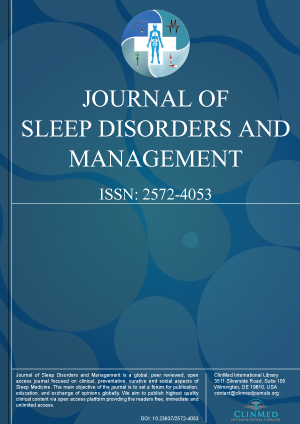Open Access DOI:10.23937/2572-4053.1510007
In Your Dreams - A Case of Presumed Rapid Eye Movement Sleep Behavior Disorder in the Inpatient Psychiatric Unit
Michelle B Collier, Stephanie D Nichols and John J Campbell
Article Type: Case Report | First Published: December 01, 2015
Unlike dyssomnias that influence quality and duration of sleep, parasomnias primarily affect behavior. Rapid eye movement (REM) sleep behavior disorder (RBD) is a parasomnia characterized by loss of normal skeletal muscle atonia during REM sleep. Usually, atonia occurs through neural inhibition via pontine nuclei to spinal motor neurons. Dysfunction, due to lesions or neurodegeneration, can lead to dream enactment. Therefore, sleepers may act violently, including: hitting, jumping, or kicking......
Open Access DOI:10.23937/2572-4053.1510006
Nightmares and Associations with Sleep Quality and Self-Efficacy among University Students
Angelika A. Schlarb, Isabel Bihlmaier, Martin Hautzinger, Marco D. Gulewitsch and Barbara Schwerdtle
Article Type: Research Article | First Published: October 27,2015
Sleep problems are a common complaint among adults. In university students international studies showed prevalence rates between 4.7 and 36.2% for sleep difficulties and 2-3% of students report nightmares. Previous studies show that nightmares are often associated with insomnia and mental strain, but also with gender. The goal of this study was to outline nightmares, associations with sleep disturbances and mental strain as well as self-efficacy among university students. An amount of 2196 stude...
Open Access DOI:10.23937/2572-4053.1510005
Sleep Pattern during Pregnancy and Maternal Depression: Study of Aube Cohort
Flora Bat-Pitault, Christine Deruelle, Sophie Flori, Veronique Porcher-Guinet, Camille Stagnara, Aurore Guyon, Sabine Plancoulaine, Joelle Adrien, David Da Fonseca, Hugues Patural and Patricia Franco
Article Type: Original Article | First Published: September 26, 2015
217 women recruited in childbirth in the maternity participated in the survey with 34 included in the MDD group. 17 among the MDD group were diagnosed PPMD. Sleep characteristics of women were assessed before and during pregnancy with self-administered questionnaires and depressive symptoms after delivery were screen with the hospital anxiety depression scale (HAD). Diagnosis of depression was performed according to DSM-IV criteria during a semi-structured interview done by phone....
Open Access DOI:10.23937/2572-4053.1510004
Kyphosis and Sleep Characteristics in Older Persons: The Rancho Bernardo Study
Che Wankie, D. Kritz-Silverstein, E. Barrett-Connor and D.M. Kado
Article Type: Original Article | First Published: September 21, 2015
Accentuated kyphosis, popularly known as the dowager's hump, is a forward curvature of the thoracic spine that appears as a humped or crooked back. Progressive kyphosis may develop as a result of spinal fractures caused by osteoporosis, postural changes due to muscle weakness, and/or degenerative disc disease. Hyperkyphosis is a common condition affecting 20-40% of older persons, but can occur less commonly among the young. In older persons, hyperkyphosis has been associated with falls, fracture...
Open Access DOI:10.23937/2572-4053.1510003
Sleep Characteristics in Blind Subjects
Fructuoso Ayala-Guerrero and Graciela Mexicano
Article Type: Research Article | First Published: September 14, 2015
The sleep patterns of ten blind adults and their matched controls were studied during three consecutive nights. The first night was allowed for adaptation. Significant electroencephalographic and quantitative findings were obtained from nights 2 and 3. Although alpha-like rhythm was registered in only one blind subject during wakefulness, it was displayed by 8 of the 10 blind participants of this study during REM sleep. This rhythm was also present during the N2 sleep stage. The delta phase of s...
Open Access DOI:10.23937/2572-4053.1510002
Marked Increases in Alpha Power Over the Left Prefrontal Region During Days Following Shift Work: A Case Report
Nirosha J. Murugan, Nicolas Rouleau, Lukasz M. Karbowski, Andrew P. Lapointe and Michael A. Persinger
Article Type: Case Report | First Published: September 10, 2015
Quantitative electroencephalographic (QEEG) measurements were completed for a 35 year old of paramedic following two to five days of shift change and rest periods. The most conspicuous and reliable change was a marked increase (factor of 5) in power within the alpha band over the left prefrontal region and, to a lesser degree, increased power within the low-beta band over the right parietal region during the test periods after no work days. These results indicate that regions of cerebral cortice...
Open Access DOI:10.23937/2572-4053.1510001
Insomnia and Emotion Regulation: Recent Findings and Suggestions for Treatment
Silvia Cerolini, Andrea Ballesio and Caterina Lombardo
Article Type: Review Article | First Published: August 28, 2015
Recent findings suggest that insomnia and emotion regulation are closely connected. Insomnia is widely associated with medical and psychiatric conditions as well as with impaired quality of life and emotional functioning. Additionally empirical evidence suggests that emotional dysregulation plays a crucial role in the onset and maintenance of psychopathological disorders. Although these seem to interact, very few studies investigated the relationship between disturbed sleep and problems in emoti...

